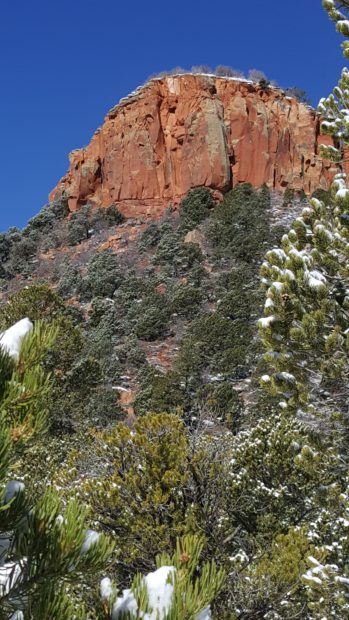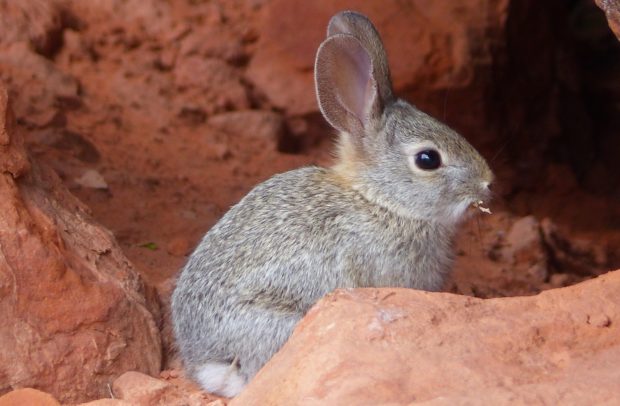We have much more to do and your continued support is needed now more than ever.
Bears Ears National Monument: Of Spirit and Nature
Bears Ears National Monument is a place where Native American culture intertwines with the high desert of the Grand Gulch Plateau in southeastern Utah.

Hiking through this expansive landscape, with lost canyons winding through the valley below, one feels a spiritual presence amid the sandstone outcrops and pinyon and juniper.
Bears Ears was named after two adjacent red-colored buttes, resembling bears’ ears, towering high above the landscape.
It is here, the Cedar Mesa, where Ancestral Puebloans inhabited the canyons between 750 and 2500 years ago. Evidence of the Basketmakers, the earliest documented inhabitants (500 BC to 750 AD), shows just how they lived in harmony with this dry desert environment. They excavated shallow pithouses and held spiritual ceremonies in what are known as “Great Kivas.” They used a weapon called the atlatl or spear thrower and darts to hunt game and cultivated corn and squash, which they stored in granaries in the rocks.
Many of the dwellings, farming areas, and rock art remain in excellent condition, hidden and blended with the natural surroundings. Bears Ears is special, and culturally and environmentally significant to our nation, two criteria for establishing a place worthy of national monument designation. Such recognition is possible under America’s Antiquities Act, signed by President Theodore Roosevelt in 1906. This law gives the U.S. President the authority to proclaim and create national monuments on federal lands. President Barack Obama declared Bears Ears National Monument (1.35 million acres) in December of 2016.
Ancestral past and natural heritage
Bears Ears stands a monument and treasured site of our ancestral past and natural heritage. Many of the wildlife species that inhabit the area were used for food and clothing by the ancient people. Ancestral Puebloans used nets or snares to catch cottontail rabbits. Infants were wrapped in rabbit fur blankets. The Puebloans also hunted desert bighorn sheep and mule deer for food and clothing, and created tools from the bones. Rock art can be seen towering above on the canyon walls, with many scenes depicting bighorn sheep.

Coexisting with nature with our ancestral beginnings is the beauty of Bears Ears, worthy of protection so this place-based landscape — kivas, cliff dwellings and rock art — can remain intact and appreciated by future generations.
The spiritual connection to the landscape also includes the region’s flora. The prehistoric peoples of Cedar Mesa used a number of the native plants for food, medicine, clothing, housing, and ornaments. Native grasses such as Indian ricegrass and dropseed were harvested in early summer and ground into meal for making bread. The prickly pear cactus provided fruits that could be peeled and eaten. Other plants such as the yucca were used for weaving baskets.
The Basketweavers and culture likely derived from earlier nomadic hunters and gathers. Artifacts from the Basketweavers are some the oldest found in the area. It is believed likely that a series of droughts drove the Basketweavers to the nearby mountains. Later, after their descendants returned around AD 1050, they brought with them the influence of the Mesa Verde people to the east and the Kayenta people to the south.
By the late 1200s, the prehistoric Puebloans moved out of the area, also likely because of the droughts of the 12th and 13th centuries, in addition to a lack of natural resources and competition with the nomadic tribes from the north. Today, the canyons of Cedar Mesa are important to the Hopi, Ute, Navajo, and various Pueblo tribes. Bears Ears is a national monument to all Americans, teeming in Native American culture and connecting us to the spiritual and natural world.
Thankfully, on October 8, 2021, President Biden restored the Monument’s boundaries so the total protected area of Bears Ears National Monument is now 1.36 million acres — restoring its integrity and upholding efforts to honor the federal trust responsibility to Tribal Nations.

Chamois Andersen is the former Executive Director of the Wyoming Wildlife Federation and a longtime advocate for wildlife and wild places.
This blog has been updated from an original version published in May 2017.





















